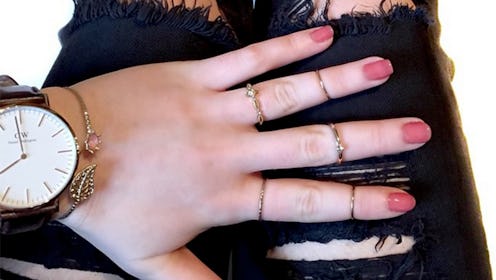
Ah, yes, the pressing question of 2015: Are gel nails safe? Recently, some research came out about how these long-lasting manicures might be somewhat unsafe, since the process employs UV lighting, which, of course, has an association with skin cancer. Given the reputation of the light source, I was immediately concerned about the risks of gel manicures, which I usually only get for major occasions like weddings where I don't want to worry about chippage.
I love the results, sure, but not if it means increasing the chances of getting skin cancer. Sure, I ask for those protective gloves when going under the lamp, but I'm of the mindset that you can never be too safe.
However, according to Vox, the FDA regulates UV nail lamps just as it does UV tanning lights. There have been no official warnings released about UV nail lamps and their dangers, with a dermatologist noting that there is probably no cause for alarm.
According to Barry Shields, managing partner for Red Carpet Manicure, gel manis are safe for a variety of reasons. They actually have some added benefits, as well. The brand, which markets an at-home system, uses LED lamps, which emit low levels of UV rays. Their SafeLight Technology eliminates the nagging questions about the light sources that cure the polish.
In simplest terms: The light emitted from the LED chip leads to fast curing and therefore, exposure is minimal.
Here are six reasons the gel mani is safer than you think.
1. Gel Manicures Add Strength And Support
While you'd think that all that polish curing might weaken the natural nail, gel manis add a protective coating that provides strength and support to the nail, according to the RCM team. As long as you don't rip it off, gel polish shouldn't damage your nails any more than a traditional variety.
2. The Duration And Frequency Of Light Exposure Is Brief
"The negativity surrounding gel manicures is due to the thought of how damaging the UV light is to the nails," Shields said. "LED lights have very minimal amounts of UV rays emitted." Still, people like me worry about the UV exposure, given its rep. The general consensus is that UV rays are extremely bad for your skin but Shields pointed out that the UV damage "depends on the duration and frequency of exposure." So as long as you aren't getting a gel manicure more than once a month, you should be in the clear.
3. LED Lamps Are Your Best Bet
RCM's at-home mani system utilizes the same products as the pros, but with a LED lamp. The quick curing time exposes hands and nails to the light for mere seconds. Exposure time is actually lightbulb dependent, but the bulbs usually require 45 seconds or a minute to cure lacquer. Ask your nail salon which type of lamp they use before you book an appointment.
4. Know Your Lamp Differences
The main difference between the LED and straight UV Lamps is efficiency. Shields said, "LED lights are a more efficient way to generate light. Just the like the LED lightbulbs used in ordinary house lighting, they last a very long time and generate adequate amounts of light. And that’s why we formulated our system using a LED light instead of a UV light." Again, the LED allows for safer and quicker curing of the gel polish with less UV rays.
5. You Can Further Protect Your Hands And Nails As Part Of The Process
Since hands show age, how can we further protect them? "Always make sure your hands are well moisturized and if your hands are exposed to the sun, always use a sunscreen," Shields said. Also, why not add another layer of protection by slathering your hands with sunscreen before engaging in a gel mani? It can't hurt.
6. Ask Questions!
Shields suggests asking these three questions to your gel mani provider. "What kind of light will you be using for my gel manicure service?," "How do I properly remove my gel manicure?," and " What are the benefits of a gel manicure?" Once you've got all that sorted, you can walk away more confident in the safety of your new polish.
Images: redcarpetmanicure/Instagram; Giphy (5)